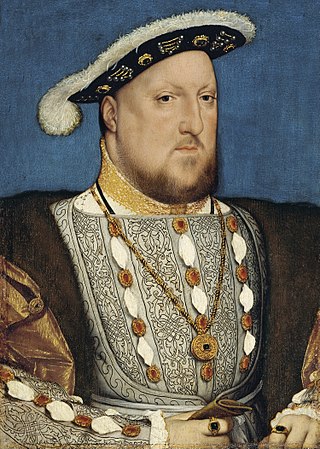Related Research Articles

Edward VI was King of England and Ireland from 28 January 1547 until his death in 1553. He was crowned on 20 February 1547 at the age of nine. Edward was the son of Henry VIII and Jane Seymour and the first English monarch to be raised as a Protestant. During his reign, the realm was governed by a regency council because he never reached maturity. The council was first led by his uncle Edward Seymour, 1st Duke of Somerset (1547–1549), and then by John Dudley, 1st Earl of Warwick (1550–1553), who from 1551 was Duke of Northumberland.

Mary I, also known as Mary Tudor, and as "Bloody Mary" by her Protestant opponents, was Queen of England and Ireland from July 1553 and Queen of Spain as the wife of King Philip II from January 1556 until her death in 1558. She is best known for her vigorous attempt to reverse the English Reformation, which had begun during the reign of her father, Henry VIII. Her attempt to restore to the Church the property confiscated in the previous two reigns was largely thwarted by Parliament, but during her five-year reign, Mary had over 280 religious dissenters burned at the stake in the Marian persecutions.

Thomas Cranmer was a leader of the English Reformation and Archbishop of Canterbury during the reigns of Henry VIII, Edward VI and, for a short time, Mary I. He helped build the case for the annulment of Henry's marriage to Catherine of Aragon, which was one of the causes of the separation of the English Church from union with the Holy See. Along with Thomas Cromwell, he supported the principle of royal supremacy, in which the king was considered sovereign over the Church within his realm.

Reginald Pole was an English cardinal of the Catholic Church and the last Catholic archbishop of Canterbury, holding the office from 1556 to 1558, during the Counter-Reformation.

John Foxe, an English historian and martyrologist, was the author of Actes and Monuments, telling of Christian martyrs throughout Western history, but particularly the sufferings of English Protestants and proto-Protestants from the 14th century and in the reign of Mary I. The book was widely owned and read by English Puritans and helped to mould British opinion on the Catholic Church for several centuries.
William Capon (1480–1550) was an English Catholic priest and scholar.
Nicholas Shaxton was an English Reformer and Bishop of Salisbury.
Anthony Kitchin, also known earlier as Dunstan Kitchin, was a mid-16th-century Abbot of Eynsham Abbey and then, Bishop of Llandaff in the Catholic Church under Henry VIII and eventually under Mary. He Seems to have had no qualms about the breach with Rome under Henry VIII, the Protestant Reformation under Edward VI and though reconciled as a Catholic under Mary I, accepted to serve when Protestantism returned under Elizabeth I.
Events from the 1530s in England.
Events from the 1550s in England. This decade marks the beginning of the Elizabethan era.

The English Reformation took place in 16th-century England when the Church of England broke away from the authority of the pope and the Catholic Church. These events were part of the wider European Reformation, a religious and political movement that affected the practice of Christianity in Western and Central Europe.
Henry Cole was an English Roman Catholic churchman and academic.
Richard Nykke became bishop of Norwich under Pope Alexander VI in 1515. Norwich at this time was the second-largest conurbation in England, after London.

Agnes Prest was a Cornish Protestant martyr from the reign of the Catholic Queen Mary. She was burned at the stake at Southernhay in Exeter in 1557.

James Basset (1526–1558) was a gentleman from the ancient Devonshire Basset family who became a servant of Stephen Gardiner, Bishop of Winchester, by whom he was nominated MP for Taunton in 1553, for Downton in 1554, both episcopal boroughs. He also served thrice as MP for Devon in 1554, 1555, and 1558. He was a strong adherent to the Catholic faith during the Reformation started by King Henry VIII. After the death of King Edward VI in 1553 and the accession of the Catholic Queen Mary I, he became a courtier to that queen as a gentleman of the Privy Chamber and received many favours from both herself and her consort King Philip II of Spain.

Thomas Benet from Cambridge, was an English Protestant martyr during the reign of King Henry VIII. In 1524, he moved to Torrington, North Devon, with his wife and family so that he could exercise his religious conscience more freely in a county where no one knew him. He was executed by burning on 15 January 1531, for heresy, at Livery Dole outside Exeter in Devon, under the supervision of Sir Thomas Dennis (c.1477-1561) of Holcombe Burnell, near Exeter, then Sheriff of Devon.
Dr Richard Gwent was a senior ecclesiastical jurist, pluralist cleric and administrator through the period of the Dissolution of the Monasteries under Henry VIII. Of south Welsh origins, as a Doctor of both laws in the University of Oxford he rose swiftly to become Dean of the Arches and Archdeacon of London and of Brecon, and later of Huntingdon. He became an important figure in the operations of Thomas Cromwell, was a witness to Thomas Cranmer's private protestation on becoming Archbishop of Canterbury, and was Cranmer's Commissary and legal draftsman. He was an advocate on behalf of Katherine of Aragon in the proceedings against her, and helped to deliver the decree of annulment against Anne of Cleves.
Edward Crome was an English reformer and courtier.
John London, DCL was Warden of New College, Oxford, and a prominent figure in the Dissolution of the Monasteries during the reign of Henry VIII of England.
References
- Concise Dictionary of National Biography (under Capon, John)
- Angelo J. Louisa, Capon [Salcot], John (d. 1557), bishop of Salisbury in Oxford Dictionary of Biography (Oxford University Press, 2004)
- John & Angela Magee, John Foxe 1517 - 1587 (https://web.archive.org/web/20150402113828/http://www.salisburyemmanuel.org.uk/John%20Foxe.pdf)